The high performance liquid chromatography tandem mass spectrometry (HPLC MS/MS) system market is expected to grow from USD 54.5 million in 2025 to USD 125.2 million by 2035, supported by expanding pharmaceutical research needs, stricter regulatory expectations for compound verification, and increasing use of targeted analytical detection in clinical and food safety laboratories. Market dynamics are influenced by the shift from manual chromatographic workflows to automated and software-driven analytical platforms that reduce operator variability and increase testing throughput. Pharmaceutical companies and research facilities are prioritizing systems that deliver high sensitivity and low detection limits for impurity profiling, drug metabolism analysis, and trace-level compound identification. Food safety laboratories continue to adopt HPLC-MS/MS systems to detect contaminants, veterinary residues, and pesticide residues where high-precision confirmation is required.
During the latter half of the forecast period, growth will be supported by integration with laboratory automation ecosystems, including robotic sample preparation systems, digital data management platforms, and centralized quality assurance logging. Instrument producers that offer cloud-enabled analytical software, validated method libraries, simplified calibration workflows, and ongoing remote performance monitoring will remain competitively stronger. Clinical application demand is expected to widen, particularly in therapeutic drug monitoring and metabolic profiling. The market will increasingly favor modular instrument configurations, scalable ion source options, and automated compatibility features that enable laboratories to expand testing capacity without disrupting workflows.
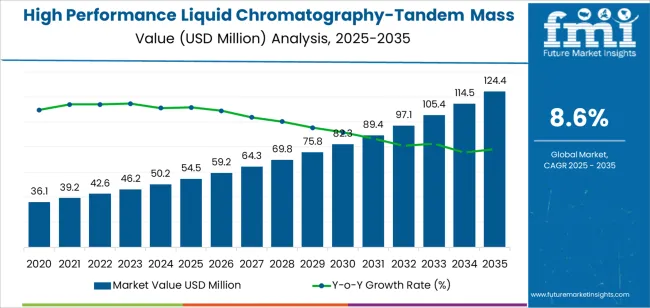
The market demonstrates distinct growth phases with varying market characteristics and competitive dynamics. Between 2025 and 2030, the market progresses through its technology adoption phase, expanding from USD 54.5 million to USD 76.0 million with steady annual increments averaging 8.6% growth. This period showcases the transition from basic analytical instrumentation formulations to advanced automatic operation systems with enhanced precision capabilities and integrated quality control systems becoming mainstream features.
The 2025-2030 phase adds USD 21.5 million to market value, representing 30% of total decade expansion. Market maturation factors include standardization of pharmaceutical testing and food safety protocols, declining component costs for specialized mass spectrometry formulations, and increasing industry awareness of analytical precision benefits reaching advanced detection effectiveness in medicine and scientific research applications. Competitive landscape evolution during this period features established analytical equipment manufacturers like AB Sciex and Waters expanding their system portfolios while specialty manufacturers focus on advanced detection development and enhanced operational capabilities.
From 2030 to 2035, market dynamics shift toward advanced automation integration and global laboratory expansion, with growth continuing from USD 76.0 million to USD 125.2 million, adding USD 49.2 million or 70% of total expansion. This phase transition centers on specialized operation systems, integration with automated laboratory networks, and deployment across diverse pharmaceutical and food testing scenarios, becoming standard rather than specialized applications. The competitive environment matures with focus shifting from basic analytical capability to comprehensive testing optimization systems and integration with laboratory management platforms.
| Metric | Value |
|---|---|
| Market Value (2025) | USD 54.5 million |
| Market Forecast (2035) | USD 125.2 million |
| Growth Rate | 8.6% CAGR |
| Leading Technology | Automatic Operation Mode |
| Primary Application | Medicine Application Segment |
The market demonstrates strong fundamentals with automatic operation systems capturing a dominant share through advanced analytical design and testing optimization capabilities. Medicine applications drive primary demand, supported by increasing pharmaceutical research volumes and precision testing technology requirements. Geographic expansion remains concentrated in developed markets with established pharmaceutical infrastructure, while emerging economies show accelerating adoption rates driven by laboratory capacity expansion and rising analytical standards.
Market expansion rests on three fundamental shifts driving adoption across the pharmaceutical, food safety, and scientific research sectors. First, analytical precision demand creates compelling operational advantages through mass spectrometry systems that provide immediate compound identification and quantitative analysis without compromising testing accuracy, enabling laboratories to meet stringent regulatory standards while maintaining research productivity and reducing analytical errors. Second, laboratory automation modernization accelerates as pharmaceutical companies worldwide seek advanced analytical systems that complement traditional testing processes, enabling precise method optimization and quality control that align with industry standards and regulatory requirements.
Third, pharmaceutical research enhancement drives adoption from drug development laboratories and clinical testing facilities requiring effective analytical solutions that maximize testing throughput while maintaining operational accuracy during sample preparation and analysis operations. Growth faces headwinds from equipment cost challenges that vary across analytical suppliers regarding the sourcing of mass spectrometry components and detector systems, which may limit adoption in cost-sensitive environments. Technical limitations also persist regarding maintenance complexity and operator training requirements that may reduce effectiveness in resource-constrained laboratory scenarios, which affect system performance and operational requirements.
The high performance liquid chromatography-tandem mass spectrometry system market represents a specialized yet critical analytical opportunity driven by expanding global pharmaceutical research, laboratory automation modernization, and the need for superior detection precision in diverse testing applications. As laboratories worldwide seek to achieve advanced analytical effectiveness, reduce testing errors, and integrate automated systems with laboratory platforms, mass spectrometry systems are evolving from basic analytical instruments to sophisticated testing solutions ensuring measurement accuracy and regulatory compliance leadership.
The market's growth trajectory from USD 54.5 million in 2025 to USD 125.2 million by 2035 at an 8.6% CAGR reflects fundamental shifts in pharmaceutical industry testing requirements and analytical precision optimization. Geographic expansion opportunities are particularly pronounced in China and India markets, while the dominance of automatic operation systems and medicine applications provides clear strategic focus areas.
Strengthening the dominant automatic operation segment through enhanced automation formulations, superior analytical precision, and integrated laboratory systems. This pathway focuses on optimizing system configuration, improving testing throughput, extending operational effectiveness to advanced detection rates, and developing specialized configurations for diverse applications. Market leadership consolidation through advanced automation engineering and laboratory integration enables premium positioning while defending competitive advantages against manual operation alternatives. Expected revenue pool: USD 8.0-11.0 million
Rapid pharmaceutical research and laboratory infrastructure growth across China creates substantial expansion opportunities through local manufacturing capabilities and technology transfer partnerships. Growing drug development activity and government analytical standards initiatives drive steady demand for advanced mass spectrometry systems. Localization strategies reduce import costs, enable faster technical support, and position companies advantageously for procurement programs while accessing growing domestic markets. Expected revenue pool: USD 7.0-9.5 million
Expansion within the dominant medicine segment through specialized system designs addressing pharmaceutical testing standards and high-volume analytical requirements. This pathway encompasses automated sample processing, regulatory compliance integration, and compatibility with diverse pharmaceutical research processes. Premium positioning reflects superior detection precision and comprehensive quality compliance supporting modern drug development. Expected revenue pool: USD 6.0-8.5 million
Strategic expansion into food applications requires enhanced detection capabilities and specialized system configurations addressing food safety operational requirements. This pathway addresses contaminant analysis, residue testing, and quality assurance applications with advanced separation engineering for demanding analytical standards. Premium pricing reflects specialized detection requirements and extended sensitivity standards. Expected revenue pool: USD 5.0-7.0 million
Development of specialized system configurations for scientific research applications and other segments, addressing specific analytical requirements and research testing demands. This pathway encompasses method development, environmental analysis, and cost-effective alternatives for emerging research segments. Technology differentiation through proprietary configurations enables diversified revenue streams while reducing dependency on single application platforms. Expected revenue pool: USD 4.5-6.5 million
Expansion of manual operation segment through accessible system designs, operator-friendly interfaces, and budget-conscious laboratory requirements. This pathway encompasses academic research applications, small-scale testing facilities, and specialized applications requiring hands-on analytical control. Market development through simplified operation engineering enables differentiated positioning while accessing cost-sensitive markets requiring reliable analytical solutions. Expected revenue pool: USD 3.5-5.0 million
Development of regulatory-compliant system configurations addressing pharmaceutical validation and food safety requirements across medicine and scientific research applications. This pathway encompasses method validation protocols, regulatory documentation, and comprehensive compliance systems. Premium positioning reflects regulatory expertise and validation capabilities while enabling access to regulated testing programs and compliance-driven laboratory partnerships. Expected revenue pool: USD 3.0-4.5 million
Primary Classification: The market segments by operation mode into Manual and Automatic categories, representing the evolution from basic operator-controlled systems to specialized automated solutions for comprehensive analytical optimization.
Secondary Classification: Application segmentation divides the market into Medicine, Food, Scientific Research, and Other Segments sectors, reflecting distinct requirements for analytical precision, testing capacity, and detection standards.
Regional Classification: Geographic distribution covers China, India, Germany, Brazil, United States, United Kingdom, Japan, and other regions, with developed markets leading adoption while emerging economies show accelerating growth patterns driven by laboratory expansion programs.
The segmentation structure reveals technology progression from standard manual-based systems toward specialized automated configurations with enhanced precision and testing capabilities, while application diversity spans from pharmaceutical analysis to specialized food safety and research applications requiring precise analytical solutions.

Market Position: Automatic operation systems command the leading position in the market with approximately 71.9% market share through advanced automation properties, including superior testing throughput, precision analytical capability, and operation optimization that enable laboratories to achieve optimal analytical performance across diverse pharmaceutical and research environments.
Value Drivers: The segment benefits from laboratory preference for reliable automated systems that provide consistent testing performance, reduced operator error, and workflow optimization without requiring significant process modifications. Advanced automation features enable integrated sample processing, analytical consistency, and integration with existing laboratory equipment, where system performance and testing reliability represent critical operational requirements.
Competitive Advantages: Automatic operation systems differentiate through proven operational stability, consistent analytical characteristics, and integration with laboratory information management systems that enhance testing effectiveness while maintaining optimal precision suitable for diverse pharmaceutical applications.
Key market characteristics:
Manual operation systems maintain cost-effective positioning in the market with approximately 28.1% market share due to their accessible operation properties and hands-on analytical advantages. These systems appeal to laboratories requiring operator-controlled instruments with adequate performance for research and educational applications. Market adoption is driven by academic laboratory expansion, focusing reliable analytical solutions and operational flexibility through operator-controlled system configurations while maintaining competitive pricing structures.

Market Context: Medicine applications dominate the market with approximately 25.2% market share due to widespread adoption of precision analytical testing and increasing focus on pharmaceutical development, drug monitoring, and quality assurance applications that minimize testing failures while maintaining pharmaceutical industry standards.
Appeal Factors: Pharmaceutical manufacturers prioritize analytical reliability, detection consistency, and integration with existing drug development infrastructure that enables coordinated testing application across multiple research programs. The segment benefits from substantial pharmaceutical industry investment and regulatory programs that emphasize the acquisition of mass spectrometry systems for quality control and compound identification applications.
Growth Drivers: Drug development programs incorporate mass spectrometry systems as standard analytical tools for pharmaceutical operations, while clinical testing growth increases demand for precision analytical capabilities that comply with regulatory standards and minimize measurement uncertainty.
Market Challenges: Varying pharmaceutical standards and drug formulation differences may limit analytical standardization across different testing facilities or operational scenarios.
Application dynamics include:
Food applications capture approximately 5.7% market share through specialized analytical requirements in food safety testing, contaminant analysis, and quality control applications. These facilities demand robust analytical systems capable of detecting trace compounds while providing exceptional sensitivity and regulatory compliance capabilities.
Scientific research applications account for market share, while other segments include environmental testing, forensic analysis, and specialized research applications requiring mass spectrometry capabilities for analytical precision and method development.
Growth Accelerators: Pharmaceutical research expansion drives primary adoption as mass spectrometry systems provide superior analytical detection capabilities that enable research laboratories to meet stringent regulatory standards without excessive equipment costs, supporting drug development and pharmaceutical missions that require precise compound identification applications. Laboratory automation infrastructure demand accelerates market expansion as pharmaceutical companies seek effective automated systems that minimize operator intervention while maintaining analytical effectiveness during sample testing and method validation scenarios. Pharmaceutical industry spending increases worldwide, creating steady demand for precision analytical systems that complement traditional laboratory processes and provide testing differentiation in competitive research markets.
Growth Inhibitors: Equipment cost challenges vary across analytical suppliers regarding the sourcing of mass spectrometry detectors and separation components, which may limit operational flexibility and market penetration in regions with budget constraints or cost-sensitive laboratory operations. Technical performance limitations persist regarding maintenance requirements and operator training needs that may reduce effectiveness in resource-limited facilities, small-scale laboratories, or academic research conditions, affecting system reliability and operational requirements. Market fragmentation across multiple pharmaceutical standards and analytical methods creates compatibility concerns between different system suppliers and existing laboratory infrastructure.
Market Evolution Patterns: Adoption accelerates in pharmaceutical research and clinical testing sectors where analytical precision justifies system costs, with geographic concentration in developed markets transitioning toward mainstream adoption in emerging economies driven by laboratory capacity expansion and regulatory awareness. Technology development focuses on enhanced automation capabilities, improved detection sensitivity, and compatibility with laboratory information systems that optimize analytical throughput and testing effectiveness. The market could face disruption if alternative analytical technologies or portable testing innovations significantly limit the deployment of mass spectrometry-based systems in laboratory applications, though the technology's unique combination of precision detection, compound identification, and quantitative analysis continues to make it preferred in pharmaceutical applications.

The market demonstrates varied regional dynamics with Growth Leaders including China (7.7% CAGR) and India (7.1% CAGR) driving expansion through pharmaceutical capacity additions and laboratory infrastructure programs. Steady Performers encompass Germany (6.6% CAGR), Brazil (6.0% CAGR), and United States (5.4% CAGR), benefiting from established pharmaceutical industries and advanced analytical technology adoption. Mature Markets feature United Kingdom (4.8% CAGR) and Japan (4.3% CAGR), where specialized pharmaceutical applications and precision testing integration support consistent growth patterns.
| Country | CAGR (2025-2035) |
|---|---|
| China | 7.7% |
| India | 7.1% |
| Germany | 6.6% |
| Brazil | 6.0% |
| United States | 5.4% |
| United Kingdom | 4.8% |
| Japan | 4.3% |
Regional synthesis reveals China and India markets leading adoption through pharmaceutical manufacturing expansion and laboratory infrastructure development, while European countries maintain steady expansion supported by pharmaceutical technology advancement and regulatory standardization requirements. North American markets show moderate growth driven by drug development applications and analytical system integration trends.
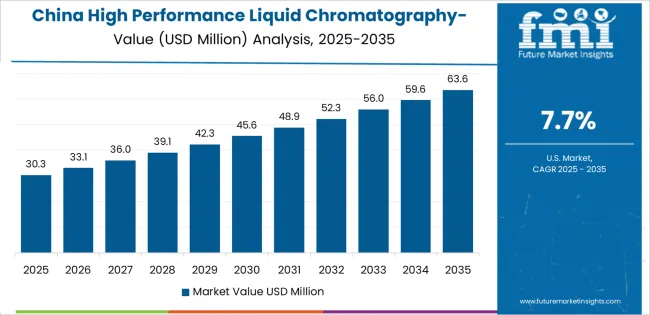
The Chinese market emphasizes advanced analytical features, including precision detection control and integration with comprehensive pharmaceutical platforms that manage testing quality, method optimization, and regulatory applications through unified laboratory systems. The country demonstrates strong growth at 7.7% CAGR, driven by pharmaceutical manufacturing expansion, laboratory infrastructure initiatives, and emerging drug development programs that support mass spectrometry integration. Chinese pharmaceutical laboratories prioritize operational effectiveness with analytical systems delivering consistent testing performance through advanced automation capabilities and method adaptation features.
Technology deployment channels include major pharmaceutical manufacturers, specialized analytical equipment suppliers, and research institute procurement programs that support professional applications for complex drug analysis and compound identification applications. Laboratory platform integration capabilities with established pharmaceutical systems expand market appeal across diverse operational requirements seeking precision detection and regulatory compliance benefits. The expanding pharmaceutical sector and accelerating drug development market create steady demand, while innovative applications in traditional medicine analysis and biosimilar testing open new growth avenues.
Performance Metrics:
Germany's advanced pharmaceutical market demonstrates sophisticated mass spectrometry deployment with documented operational effectiveness in drug development applications and research facilities through integration with existing analytical systems and laboratory infrastructure. The country leverages engineering expertise in precision instrumentation and pharmaceutical systems integration to maintain strong growth at 6.6% CAGR. Industrial centers, including Frankfurt, Munich, and Hamburg, showcase premium installations where mass spectrometry systems integrate with comprehensive laboratory platforms and quality management systems to optimize pharmaceutical testing and analytical effectiveness.
German pharmaceutical companies prioritize system reliability and EU compliance in analytical development, creating demand for precision systems with advanced features, including method validation and automated data processing. The market benefits from established pharmaceutical infrastructure and a willingness to invest in analytical technologies that provide long-term research benefits and compliance with international regulatory and quality standards.
Market Intelligence Brief:
The U.S. mass spectrometry market demonstrates sophisticated deployment across pharmaceutical applications with documented effectiveness in drug development and clinical testing facilities through integration with comprehensive laboratory management systems and regulatory infrastructure. The country leverages advanced research capabilities in analytical innovation and pharmaceutical technologies to maintain moderate growth at 5.4% CAGR. Industrial centers, including Boston, San Francisco, and Research Triangle, showcase premium installations where mass spectrometry systems integrate with comprehensive pharmaceutical platforms and drug discovery networks to optimize analytical performance and testing effectiveness.
American pharmaceutical companies prioritize testing precision and regulatory compliance in analytical development, creating demand for advanced systems with sophisticated features, including high-resolution detection and automated sample processing. The market benefits from established pharmaceutical infrastructure and willingness to invest in analytical technologies that provide long-term research benefits and compliance with FDA and international standards.
Market Intelligence Brief:
The U.K. mass spectrometry market demonstrates advanced pharmaceutical deployment with documented operational effectiveness in drug development applications and research facilities through integration with existing regulatory systems and laboratory infrastructure. The country leverages pharmaceutical expertise in analytical testing and research systems integration to maintain steady growth at 4.8% CAGR. Industrial centers, including Oxford, Cambridge, and London, showcase premium installations where mass spectrometry systems integrate with comprehensive pharmaceutical platforms and research management systems to optimize regulatory compliance and analytical effectiveness.
British pharmaceutical companies prioritize system validation and regulatory compliance in analytical development, creating demand for certified systems with advanced features, including method qualification and regulatory documentation. The market benefits from established pharmaceutical infrastructure and commitment to invest in analytical technologies that provide long-term research benefits and compliance with UK and EU regulatory standards. Drug development applications, clinical research systems, and pharmaceutical quality programs drive diversified demand across multiple application segments.
Strategic Market Indicators:
India's mass spectrometry market demonstrates rapid expansion deployment with documented operational effectiveness in pharmaceutical applications and research facilities through integration with emerging laboratory systems and drug development infrastructure. The country leverages growing pharmaceutical capabilities in analytical testing and research systems integration to achieve high growth at 7.1% CAGR. Industrial centers, including Mumbai, Hyderabad, and Bangalore, showcase expanding installations where mass spectrometry systems integrate with comprehensive pharmaceutical platforms and testing networks to optimize market penetration and analytical effectiveness.
Indian pharmaceutical companies prioritize analytical precision and quality standards in system development, creating demand for sophisticated analytical instruments with advanced features, including automated operation and regulatory compliance. The market benefits from expanding pharmaceutical infrastructure and willingness to invest in international-standard analytical technologies that provide testing differentiation and compliance with global quality standards.
Market Intelligence Brief:
Japan's mass spectrometry market demonstrates precision deployment with documented operational effectiveness in pharmaceutical applications and research facilities through integration with advanced laboratory systems and quality control infrastructure. The country leverages engineering excellence in precision instrumentation and analytical systems integration to maintain steady growth at 4.3% CAGR. Industrial centers, including Tokyo, Osaka, and Yokohama, showcase premium installations where mass spectrometry systems integrate with comprehensive quality platforms and pharmaceutical testing systems to optimize analytical excellence and detection effectiveness.
Japanese pharmaceutical companies prioritize system precision and analytical excellence in instrument development, creating demand for high-precision systems with advanced features, including ultra-high sensitivity detection and precision control systems. The market benefits from established pharmaceutical infrastructure and commitment to invest in highest-quality analytical technologies that provide superior testing performance and compliance with stringent Japanese quality standards.
Strategic Market Indicators:
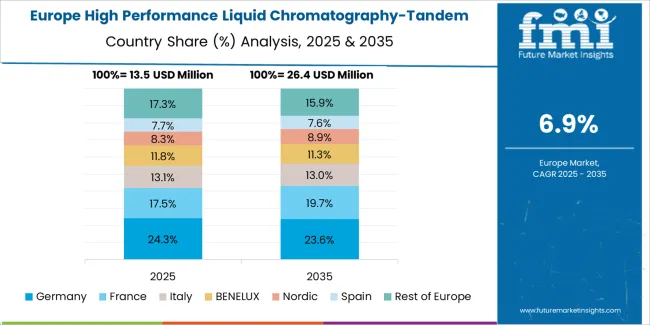
The high performance liquid chromatography-tandem mass spectrometry system market in Europe is projected to grow substantially over the forecast period, with Germany expected to maintain its leadership position with a significant market share supported by its advanced pharmaceutical infrastructure and major research centers in Frankfurt and Munich. United Kingdom follows with strong market presence, driven by comprehensive pharmaceutical research programs and clinical testing initiatives. France holds substantial market share through specialized drug development activities, analytical testing applications, and pharmaceutical manufacturing. Italy commands notable market presence through pharmaceutical research and quality control projects. Spain accounts for growing market share aided by pharmaceutical manufacturing expansion and analytical testing adoption. The Netherlands maintains steady share driven by specialty pharmaceutical applications and research laboratory demand. The Rest of Europe region is anticipated to show steady adoption, reflecting consistent growth in Nordic countries, pharmaceutical research expansion in Central European markets, and laboratory infrastructure upgrades across Eastern European research facilities.
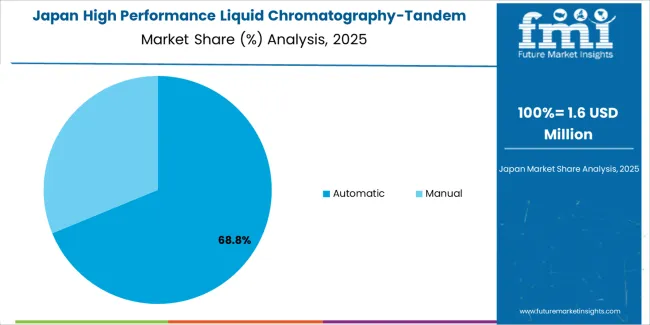
In Japan, the market prioritizes automatic operation systems, which capture the dominant share of pharmaceutical and research installations due to their advanced features, including precision workflow optimization and seamless integration with existing laboratory infrastructure. Japanese pharmaceutical laboratories emphasize reliability, precision, and long-term operational excellence, creating demand for automatic systems that provide consistent analytical capabilities and superior testing performance based on regulatory requirements and quality standards. Manual operation maintains secondary positions primarily in academic research applications and educational laboratory installations where operator-controlled functionality meets analytical requirements without compromising testing efficiency.
Market Characteristics:
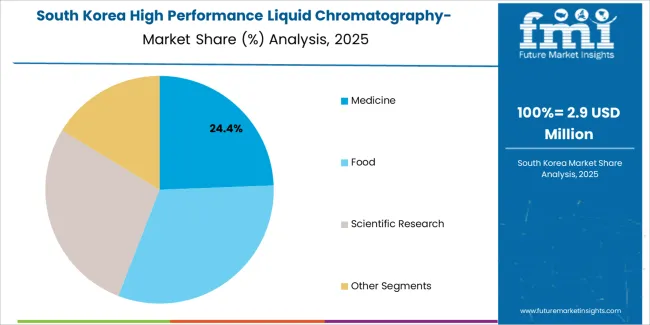
In South Korea, the market structure favors international analytical manufacturers, including AB Sciex, Waters, and Agilent, which maintain dominant positions through comprehensive product portfolios and established pharmaceutical industry networks supporting both drug development and clinical testing installations. These providers offer integrated solutions combining advanced mass spectrometry systems with professional technical services and ongoing analytical support that appeal to Korean pharmaceutical companies seeking reliable precision testing systems. Local laboratory equipment distributors and technical service providers capture moderate market share by providing localized service capabilities and competitive pricing for standard pharmaceutical testing installations, while domestic manufacturers focus on specialized applications and cost-effective solutions tailored to Korean pharmaceutical market characteristics.
Channel Insights:
The market operates with moderate concentration, featuring approximately 10-12 meaningful participants, where leading companies control roughly 55-60% of the global market share through established pharmaceutical relationships and comprehensive analytical system portfolios. Competition emphasizes advanced detection capabilities, automation integration, and pharmaceutical laboratory compatibility rather than price-based rivalry. The market structure reflects specialized analytical instrumentation requirements where technology expertise and regulatory compliance create significant barriers to entry.
Market Leaders encompass AB Sciex Pte. Ltd., Waters, and Agilent, which maintain competitive advantages through extensive mass spectrometry expertise, global pharmaceutical laboratory networks, and comprehensive method development capabilities that create customer loyalty and support premium pricing. These companies leverage decades of analytical technology experience and ongoing innovation investments to develop advanced systems with precision detection control and automation features. Technology Innovators include EAGU, AELAB, and regional specialists, which compete through specialized system configuration focus and innovative automation capabilities that appeal to laboratories seeking advanced analytical solutions and testing differentiation.
These companies differentiate through rapid method development cycles and specialized pharmaceutical application focus. Regional Specialists feature analytical equipment manufacturers focusing on specific geographic markets and specialized applications, including automated laboratory systems and integrated pharmaceutical solutions. Market dynamics favor participants that combine reliable detection performance with advanced automation capabilities, including precision analytical control and comprehensive method optimization features. Competitive pressure intensifies as traditional laboratory equipment suppliers expand into pharmaceutical testing systems, while specialized analytical companies challenge established players through innovative detection solutions and automated platforms targeting drug development and clinical testing segments.

| Item | Value |
|---|---|
| Quantitative Units | USD 54.5 million |
| Operation Mode | Manual, Automatic |
| Application | Medicine, Food, Scientific Research, Other Segments |
| Regions Covered | China, India, Germany, Brazil, United States, United Kingdom, Japan, and additional countries |
| Key Companies Profiled | AB Sciex Pte. Ltd., Waters, EAGU, AELAB, Agilent, Drawell, Beijing BGI-GBI Biotech Co., Ltd., Hunan Kailaipu Biotechnology Co., Ltd., Puju Medical, Wuhan BGI Biomedical Engineering Co., Ltd., Anhui Wanyi Science and Technology Co., Ltd. |
| Additional Attributes | Dollar sales by operation mode and application categories, regional adoption trends across China, India, Germany, and other key markets, competitive landscape with analytical equipment manufacturers and pharmaceutical laboratory suppliers, laboratory preferences for automation and precision detection, integration with pharmaceutical testing platforms and quality monitoring systems, innovations in automated analytical configurations and detection excellence, and development of regulatory-compliant solutions with enhanced performance and testing optimization capabilities. |
The global high performance liquid chromatography-tandem mass spectrometry system market is estimated to be valued at USD 54.5 million in 2025.
The market size for the high performance liquid chromatography-tandem mass spectrometry system market is projected to reach USD 124.4 million by 2035.
The high performance liquid chromatography-tandem mass spectrometry system market is expected to grow at a 8.6% CAGR between 2025 and 2035.
The key product types in high performance liquid chromatography-tandem mass spectrometry system market are automatic and manual.
In terms of application, medicine segment to command 25.2% share in the high performance liquid chromatography-tandem mass spectrometry system market in 2025.






Full Research Suite comprises of:
Market outlook & trends analysis
Interviews & case studies
Strategic recommendations
Vendor profiles & capabilities analysis
5-year forecasts
8 regions and 60+ country-level data splits
Market segment data splits
12 months of continuous data updates
DELIVERED AS:
PDF EXCEL ONLINE
High Current Power Supply for Electrophoresis Market Size and Share Forecast Outlook 2025 to 2035
High Voltage Cable Termination Market Size and Share Forecast Outlook 2025 to 2035
High Security Wedge Barricades Market Size and Share Forecast Outlook 2025 to 2035
High Purity Chemical Filters Market Size and Share Forecast Outlook 2025 to 2035
High-vacuum Fiber Feedthrough Flanges Market Size and Share Forecast Outlook 2025 to 2035
High Pressure Grease Hose Market Size and Share Forecast Outlook 2025 to 2035
High Performing Matting Agent Market Size and Share Forecast Outlook 2025 to 2035
High Reliability Oscillators Market Size and Share Forecast Outlook 2025 to 2035
High Purity Magnesium Citrate Market Size and Share Forecast Outlook 2025 to 2035
High-frequency RF Evaluation Board Market Size and Share Forecast Outlook 2025 to 2035
High Viscosity Mixer Market Size and Share Forecast Outlook 2025 to 2035
High Voltage Ionising Air Gun Market Size and Share Forecast Outlook 2025 to 2035
High Voltage Equipment Market Forecast and Outlook 2025 to 2035
High Clear Film Market Size and Share Forecast Outlook 2025 to 2035
High Precision Microfluidic Pump Market Size and Share Forecast Outlook 2025 to 2035
High Temperature Heat Pump Dryers Market Size and Share Forecast Outlook 2025 to 2035
High Temperature Fiberglass Filter Media Market Size and Share Forecast Outlook 2025 to 2035
High Purity Tungsten Hexachloride Market Size and Share Forecast Outlook 2025 to 2035
High Purity Nano Aluminum Oxide Powder Market Size and Share Forecast Outlook 2025 to 2035
High Mast Lighting Market Forecast and Outlook 2025 to 2035

Thank you!
You will receive an email from our Business Development Manager. Please be sure to check your SPAM/JUNK folder too.
Chat With
MaRIA